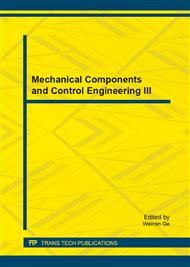p.3
p.8
p.12
p.17
p.22
p.27
p.31
p.35
Comparison Research of Aircraft Panels Connected by Friction Stir Welding and Riveting
Abstract:
Currently, friction stir welding has had a wide application in connection of aircraft panels. However, researches are rarely carried on in domestic aeronautics field, which involves the differences between FSW panels and traditional riveted panels in aspects of strength and stabilities under various working conditions such as shear and tension and compression. Picture frame fixture was used in this research for comparison test between two types of aircraft panels, which were connected to stringers by riveting and friction stir welding (FSW). Finite element models were established to simulate the panels in the shear tests which proposed a method to simulate the connection types. It is found that the FSW connection performs better than riveted connection in aspects of limiting load and initial buckling load, which proved that panel connected by FSW is better than riveting in mechanical properties. The test result is proved by FEM simulation, and vise versa.
Info:
Periodical:
Pages:
3-7
Citation:
Online since:
October 2014
Authors:
Price:
Сopyright:
© 2014 Trans Tech Publications Ltd. All Rights Reserved
Share:
Citation:


